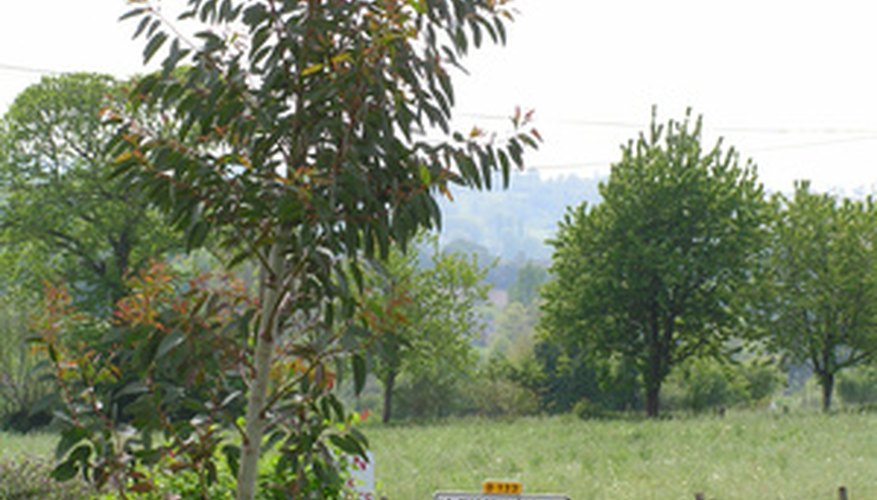Eucalyptus trees are native to Australia but can be grown in any warm, dry area of the United States. The tree produces thick, oval-shaped leaves that can be green, maroon or bluish grey. When the leaves are crushed or split open, an oil is released that scents the air. Growing grass directly under or near Eucalyptus trees can be difficult but is possible with an ongoing maintenance program.
Purchase a grass seed based on the amount of sunlight the area receives. When the eucalyptus tree is young and has few branches, choose a grass that grows in full to partial sunlight. For mature eucalyptus trees with an abundance of foliage, choose a shade grass variety.
- Eucalyptus trees are native to Australia but can be grown in any warm, dry area of the United States.
- When the eucalyptus tree is young and has few branches, choose a grass that grows in full to partial sunlight.
Rake the area around the eucalyptus tree thoroughly to remove all of the fallen leaves.
Rake the area near the Eucalyptus tree with a wide-toothed rake to loosen the soil to a 1-inch depth in preparation for seeding. Spread 1 to 2 inches of compost onto the area and work it into the soil with the rake.
- Rake the area around the eucalyptus tree thoroughly to remove all of the fallen leaves.
- Rake the area near the Eucalyptus tree with a wide-toothed rake to loosen the soil to a 1-inch depth in preparation for seeding.
Spread the grass seed onto the surface of the soil at the rate specified by the grass seed package. Do not place grass seed within 3 to 4 inches of the Eucalyptus tree trunk.
Rake the ground again lightly with the rake to mix the seeds into the soil.
Water the soil once or twice per day to keep it constantly moist until the grass seeds germinate. It is important to water the grass manually because the eucalyptus tree root will absorb all moisture from rainfall. When the grass blades are mature, reduce watering to once per week and water for two hours at a time.
Wait until the grass blades reach 3 to 4 inches high and begin raking the area lightly on a weekly basis to remove all fallen eucalyptus leaves. Eucalyptus leaves contain an oil that prevents them from decomposing as fast as other material. If left on the grass, the leaves will kill the grass. You will need to do this throughout the year since the eucalyptus is an evergreen tree.
- Wait until the grass blades reach 3 to 4 inches high and begin raking the area lightly on a weekly basis to remove all fallen eucalyptus leaves.
- Eucalyptus leaves contain an oil that prevents them from decomposing as fast as other material.
Apply fertiliser to the grass in the early spring and again in the fall. In spring choose a granular fertiliser that is high in nitrogen, and in the fall choose a granular fertiliser that is high in potassium. Apply at the rates specified on the fertiliser package.
Spread a 1-inch layer of compost onto the grass area each spring as a top dressing. Spread the compost out so that it sinks down in between the grass blades and does not cover them up. Water the ground immediately after applying the compost.
TIP
You will need to overseed the sun loving grass with a shade grass as the tree matures.
